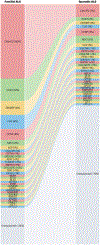Amyotrophic lateral sclerosis: translating genetic discoveries into therapies
- PMID: 37024676
- PMCID: PMC10611979
- DOI: 10.1038/s41576-023-00592-y
Amyotrophic lateral sclerosis: translating genetic discoveries into therapies
Abstract
Recent advances in sequencing technologies and collaborative efforts have led to substantial progress in identifying the genetic causes of amyotrophic lateral sclerosis (ALS). This momentum has, in turn, fostered the development of putative molecular therapies. In this Review, we outline the current genetic knowledge, emphasizing recent discoveries and emerging concepts such as the implication of distinct types of mutation, variability in mutated genes in diverse genetic ancestries and gene-environment interactions. We also propose a high-level model to synthesize the interdependent effects of genetics, environmental and lifestyle factors, and ageing into a unified theory of ALS. Furthermore, we summarize the current status of therapies developed on the basis of genetic knowledge established for ALS over the past 30 years, and we discuss how developing treatments for ALS will advance our understanding of targeting other neurological diseases.
© 2023. This is a U.S. Government work and not under copyright protection in the US; foreign copyright protection may apply.
Conflict of interest statement
Competing interests
B.J.T. holds a patent on the diagnostic and therapeutic applications of the pathogenic repeat expansion in
Figures




References
-
- Rowland LP & Shneider NA Amyotrophic lateral sclerosis. N. Engl. J. Med 344, 1688–1700 (2001). - PubMed
-
- Xu L et al. Global variation in prevalence and incidence of amyotrophic lateral sclerosis: a systematic review and meta-analysis. J. Neurol 267, 944–953 (2020). - PubMed
-
- U.S. Food and Drug Administration. Meeting of the Peripheral and Central Nervous System Drugs Advisory Committee Meeting [online], https://www.youtube.com/watch?v=AVVZMMvDOUg (2022).
Related links
-
- Answer ALS: https://www.answerals.org/
-
- Clinical trial information for Engensis (VM202): https://alsnewstoday.com/vm202/
-
- N=1 Collaborative network: https://www.n1collaborative.org/
-
- New York Genome Center ALS Consortium: https://www.nygenome.org/als-consortium/
Publication types
MeSH terms
Grants and funding
LinkOut - more resources
Full Text Sources
Medical
Miscellaneous

